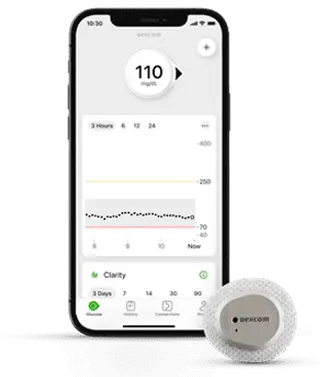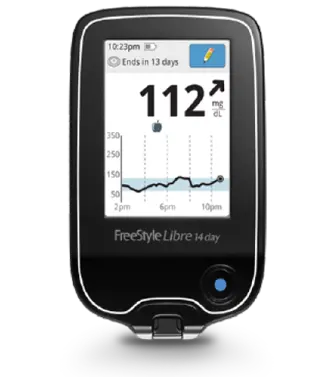How continuous glucose monitoring works
Sensor collects data
Unlike traditional blood glucose meters that require frequent finger-prick tests, CGM systems utilize a small sensor placed under your skin, typically on your abdomen or arm. This sensor continuously measures your glucose levels in the interstitial fluid, providing a detailed picture of your glucose trends throughout the day and night.
Glucose readings are displayed on your smartphone
Instantly see how your meals, activity, and lifestyle choices affect your glucose levels. The data is instantly pushed to your smartphone, powered with alerts and tracking tool to optimize your health.

How a CGM can benefit you
You might already know about traditional blood glucose monitoring (BGM) that requires fingerstick tests to measure your glucose at specific moments. Continuous Glucose Monitoring (CGM), on the other hand, offers a comprehensive view of your glucose levels over time. It delivers ongoing insights into your glucose trends, empowering you with the information you need to make better-informed decisions about managing your diabetes.
Exploring Top CGMs
Here are three top-tier CGMs that stand out for their accuracy, user-friendliness, and advanced features:
Dexcom
Renowned for its accuracy and continuous real-time glucose monitoring, Dexcom CGMs ...
Learn More
FreeStyle Libre 2
Building upon the success of the original FreeStyle Libre, the FreeStyle Libre 2 takes it a step ...
Learn More

Empowering Your Understanding
Navigating the world of Continuous Glucose Monitoring (CGM) may raise questions. Here are answers to some commonly asked queries to support your journey:
How does a CGM work?
CGM systems consist of a small sensor placed under the skin, continuously measuring glucose levels in the interstitial fluid. These readings are transmitted to a receiver or smartphone, providing real-time or historical data on glucose trends.
Are CGMs accurate?
CGMs offer high accuracy, but individual experiences may vary. Factors like calibration, sensor placement, and device differences can influence accuracy. Regularly cross-referencing CGM readings with fingerstick tests can help ensure reliability.
Is a prescription needed for a CGM?
Yes, CGMs typically require a prescription from a healthcare provider. They assess your medical history and needs to determine if a CGM is suitable for you.
Can I shower or swim with a CGM?
Most CGM sensors are waterproof and designed to withstand showering and swimming. However, prolonged exposure to water or extreme conditions might affect sensor accuracy.
How often should a CGM sensor be replaced?
Sensor lifespan varies by brand and model, typically lasting from a few days to a couple of weeks. Follow the manufacturer's guidelines for sensor replacement to ensure accurate readings.
Do CGMs require calibration with fingerstick tests?
Some CGMs need periodic calibration to ensure accuracy. However, newer models, like the FreeStyle Libre, don't require routine fingerstick calibrations, offering greater convenience.
Can CGMs be used by children or older adults?
CGMs are suitable for individuals of different ages. Some models may have age-specific recommendations, so consulting a healthcare professional is advisable for personalized guidance.
